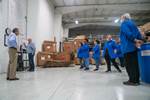Finding People Is One Thing – Keeping Them Is Another
Everyone bemoans the difficulty of finding workers. Are you doing enough to hold onto the ones you have?

Our August 2019 cover story.
Earlier this week, I moderated a webinar on robotics and automation from Wittmann Battenfeld. Quite understandably, the presenter, Chris Unseth, regional sales manager for injection molding machinery and robots, began by citing the widespread scarcity of workers as an impetus to automate:
“Everywhere I go, I see ‘Help Wanted’ signs, from the biggest molders to the smallest. And even when applicants can be found, there is the added time vetting, interviewing and training new workers. And then, one can only hope they stick around for a while. There are countless horror stories out there, but one that sticks in my mind was of a customer that offered jobs to seven applicants … five accepted … three actually showed up … and only one made it through the whole first day. One of the people who quit mid-shift, when asked why he was leaving, answered, ‘Well, sorry, I forgot how long eight hours was.’”
There may be few, if any, shortcuts to finding people. There are organizations that help to employ veterans. We have written about molders that sponsor student tours and other outreach to local high schools and community colleges.
But, if you are fortunate enough to find people willing to give working in plastics a try, the urgent task ahead is retaining them. The headline on the cover pictured here tells it all: “Focus on Your People First.” That quote came from Natech Plastics in Ronkonkoma, N.Y., where David Katchoui, director of business development, told me, “The goal of management is to nurture pride of workmanship.” You want your workers to feel that I want to do a good job because it feels good, because I want to accomplish something.
There are a number of ways to approach this goal. We’ve written about molders like Winzeler Gear in Chicago, that cultivated promising employees by paying for further technical education. Natech and other molders work hard to build a company culture that appreciates and rewards employee engagement, that encourages employees to work together in groups to identify and solve problems. My colleague, executive editor Tony Deligio, explores this in his November cover story on D&M Plastics in Burlington, Ill., where daily “huddles” are core ingredients of company culture.
D&M and other molders also make a point of sharing corporate performance metrics with shop-floor employees. Some even go so far as to hang a large screen on a wall of the plant that displays current productivity and quality performance. As Peyton “Chip” Owen Jr., owner of D&M Plastics, says in November’s On-Site feature, “Our employees ought to know what we’re doing every month,” Owen says. “They pretty much know how much we have to do in order to break even. I want them to be aware of that. What they do every day has an impact on our success.”
Related Content
-
Back to Basics on Mold Venting (Part 2: Shape, Dimensions, Details)
Here’s how to get the most out of your stationary mold vents.
-
What to Look for in High-Speed Automation for Pipette Production
Automation is a must-have for molders of pipettes. Make sure your supplier provides assurances of throughput and output, manpower utilization, floor space consumption and payback period.
-
Process Monitoring or Production Monitoring—Why Not Both?
Molders looking to both monitor an injection molding process effectively and manage production can definitely do both with tools available today, but the question is how best to tackle these twin challenges.
















